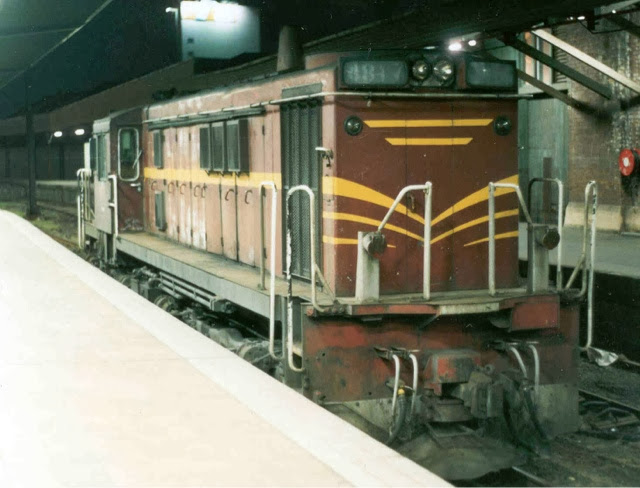This is the start of a series of blogs which have been
formulating within the grey matter for a number of months. While I and other family members have taken
photos across hundreds of NSW locations over the past five decades, perhaps the
most thematically interesting has been the series taken in our own backyard –
so to speak.
I speak of a location just south of North Wollongong
station, where the South Coast railway line rolled past my paternal
grandparents’ home. From a gate in the
back fence one could step out onto the Railway’s land to watch trains
pass. Often there was insufficient time
to unbolt the gate so it was necessary to just hang over the fence.
For a child, a four foot high paling fence was fairly
impregnable so one had to rely on assistance.
Taller kids could stand on the upturned buffer which had been planted
adjacent to the gate. Slightly shorter
kids used the buffer as a step up into a soil-filled ‘dunny can’ which was growing
mint. Or one could rely on adult
assistance, which I did from the youngest age. As can be seen from the next
photograph, this blogger was made pretty comfortable at this location from
fairly early on – thank you uncles!
Freight trains approaching from the north gave little
advance notice of their arrival, and so it was with express passenger
trains. Local passengers were more
obliging; whistling upon departure from North Wollongong station – or ‘Norf
Gong’ as it was more frequently referred to.
The lack of warning about trains from the north was
counterbalanced by trains headed to Sydney.
From several steps out onto the railway property it was possible to see
the mile or so south to Wollongong Station.
For many years, seasoned train hunters at this location had
their best warning about approaching trains by just looking southwards about
400 yards or so. There, until its demise
in the mid-1980s, the Gipps Street level crossing stood – making it a
relatively simple task to see whether the boom gates were positioned at the
vertical or had been lowered.
Now, before we launch into a few of this collection, there
is nothing particularly stunning about the location or many of the photographic
compositions. They are prosaic scenes,
made less so by the passage of time. The
sun rose in the morning – meaning that morning photographs were usually
backlit, and many photos were very hurriedly composed using both a manual focus and
light meter. And then time has
deteriorated the colours and sharpness of the details in many photographs.
However, taken together the photos encapsulate a pretty good
experience of workings across four decades from 1960 onwards. I am grateful to those who snapped away when
photography was a relatively expensive hobby. Coming into the backyard there
was always a heightened expectation that something was going to come by, just
if the back gate was open. Often the
family camera could be seen hanging off a fence paling and more than once I
recall seeing the camera hooked around the neck of a family member mowing lawns
or gardening.
Enough reminiscing! Lets start with the very ordinary (in
the nice sense). It is a 30 class tank headed north with the morning pick-up in
the early 1960s. The S wagons at the head of the train are likely to be for
Thirroul, but may have been shunted off before then.
On another day, 3093 does the honours with the same train.
Books on the subject note the affinity 32 class locomotives
had with Illawarra workings. They were ideally suited for the role, with good
acceleration and the ability to climb with decent loads. In the next photograph, 3227 heads to Sydney
with a consist typical for the early 1960s.
In the afternoon, the schoolies’ train ran with whatever
loco was available at Thirroul depot. On this day, thought to be in 1964, 5273 heads
the schoolies’ south to Kiama. There are
few items of interest to note with this photo, including the ‘tuscan and
russet’ livery on the first carriage.
Also notable is the sizeable passionfruit vine over the wood shed and
the use of railway sleepers as fence posts.
Keen eyed viewers will note a juvenile eucalyptus tree growing in the
railway corridor. This tree is absent in
later photographs, for which the official line is to express appreciation to
the authorities for its removal. I am
sure that that is precisely what happened!
And to finish up on this post, its time for a doubleheader.
I do not have immediate access to my learned counsel on this one, so I am
making an informed guess that 3034 is light attached in order for it to work
the Moss Vale ‘squirt’ out of Wollongong after the P class heads further
south. The thing I find most interesting
about this photograph is the laconic manner of the two firemen on the locos,
seemingly having a chat down the length of the P class.
Plenty more to come so please stay tuned!



















































